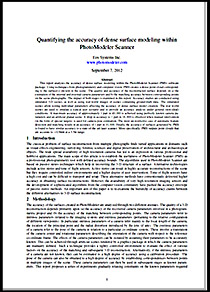PhotoModeler’s Dense Surface Modeling Accuracy Study

The full accuracy study article can be found here: Quantifying the accuracy of dense surface modeling within PhotoModeler Scanner.
The article shows that PhotoModeler Scanner can match (if not exceed) the accuracy of a laser scanner. Using a laser scanned scene as a benchmark, PhotoModeler Scanner is able to reconstruct the same scene to within an error of 0.9mm at a 3.5m range. This is well within the distance error (+/- 2mm at 10m) of the laser scanner. PhotoModeler can provide the accuracy of a laser scanner with the cost, portability and convenience of photogrammetry (using your camera and software).
This report also demonstrates the optimal way to set up photogrammetry projects to maximize DSM accuracy. Some of the project parameters discussed are:
- Base-to-Height Ratio: the ratio of the separation of two cameras in the horizontal plane (baseline) relative to their distance away from the surface being measured (height).
- Camera Angle: the angle between the look direction of two cameras.
- Texture: the appearance of a surface.
Our experiments show that maximum accuracy is achieved (for a planar surface) when a base-to-height ratio of 0.6 and a camera angle of 30 degrees is used to measure a surface with random texture. PhotoModeler can achieve an accuracy of 1 part in 44,000 with such a configuration. [A ‘1 part in N’ accuracy is a measure which is independent of scale or dimensional units. It tells us how large a quantity must be in order to produce an error of 1 unit. For example, an accuracy of 1 part in 44,000 implies that a project with an object or scene of 44m will have an error of 1mm (one sigma).]
This report also highlights the two major factors affecting the accuracy of a dense surface model creation using PhotoModeler Scanner:
- Camera Parameters: refers to both the intrinsic and extrinsic parameters of a camera. The intrinsic parameters are quantities like focal length and radial distortion. The extrinsic parameters refer to the position and angles of the different viewpoints of the photographs.
- Dense Matching: refers to the correlation based triangulation of corresponding points on photos of the scene.
In the simulations conducted, we observe that the accuracy of the camera parameters is the most important factor in surface quality. A high accuracy of 1 part in 44,000 is achieved when the camera parameters are perfectly known. In such a scenario, the dense matching quality is the only factor in the reconstruction of the scene. When the camera orientation is not known, but instead is solved using targets in the scene, the accuracy drops to 1 part in 18,000. In the fully automated case (using Smart Match and with no targets), the accuracy drops to 1 part in 9,000. See the table below to see what this means in absolute terms.
Given these observations, how do we achieve an accurate surface reconstruction? The experimental studies suggest that increasing the number of unique viewpoints (photos) of the scene leads to better surface quality. We observe an increase from 1 part in 5,000 with 2 photos to 1 part in 9,000 with 6 photos of a planar scene.
Finally, PhotoModeler Scanner provides a lot of flexibility with several internal parameters that affect the accuracy of the reconstructed surface. These parameters (sampling factor, window size, texture setting etc.) mainly trade-off accuracy for speed of surface reconstruction. For example, our simulations show that the downsampling factor and the accuracy share a linear relationship – when less downsampling is used the processing is slower but accuracy increases. The accuracy numbers mentioned have been summarized in the table found below. The error column of the table refers to the error in measuring dimensions of a 15 feet (4.5m) surface.
Summary
In conclusion, PhotoModeler Scanner is a professional photogrammetry tool with high accuracy and is able to match the capabilities of a state-of-the-art laser scanner.
| Objective | Experiment | 1 in N Accuracy | RMS Error (mm), for a 4.5m object |
|---|---|---|---|
| How does PMS compare to benchmark? | PMS Cloud to Laser Scanner Cloud Comparison | 1 in 5,000 | 0.90 |
| What is the best way to setup the scene? | Perfectly known camera parameters | 1 in 44,000 | 0.10 |
| How do orientation and dense matching affect accuracy? | Perfectly known orientation | 1 in 44,000 | 0.10 |
| Estimated orientation using targets | 1 in 18,000 | 0.25 | |
| Estimated orientation using SmartMatch | 1 in 9,000 | 0.50 | |
| How can we increase accuracy? | Effect of number of cameras | 1 in 1,500 to 1 in 9,000 | 3 to 0.5 |
| What flexibility do internal parameters of PMS offer? | Effect of resolution | 1 in 5,500 to 1 in 33,000 | 0.82 to 0.13 |
| Effect of window size | 1 in 30,000 to 1 in 50,000 | 0.17 to 0.09 | |
| Effect of texture setting | 1 in 18,000 to 1 in 30,000 | 0.25 to 0.17 |
